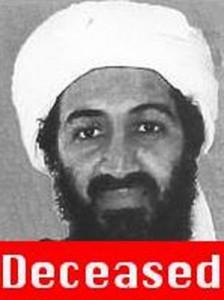On science blogs this week: bin Laden
THE DEATH OF OSAMA BIN LADEN: GENOMICS. The US government says it is certain that it was really Osama bin Laden the Navy Seals took out. There are a number of reasons why, including facial recognition software. But probably most persuasive is DNA-matching to family members, yielding results that are said to be 99.9% accurate. Erika Check Hayden explores the possibilities, extrapolating from the sparse information released, at Nature's Great Beyond.
And yes, it could have been done easily in the brief time between the assassination and bin Laden's burial at sea not long after. It's superfast on cop shows, but in the real world, DNA analysis takes weeks. Much of that time, however, is due to normal human sluggishness. Analyzing DNA via 3 conventional steps that would show whether its owner was (or was not) closely related to the owner of another batch of DNA could take less than 5 hours, according to Christie Wilcox, a grad student who blogs at Confessions of a Nerd, transferring this post to SciAm as a guest blogger. "And for all I know, the FBI has a faster way of doing it — I wouldn't exactly be shocked," she says.
Another SciAm guest blogger is Susanna Speier, a scriptwriter whose credentials include working as an intern on a couple of the CSI TV shows. She speculates on the possibility of a portable DNA analyzing kit that could have worked much faster, maybe even at the scene. Except that no such kit exists. Yet. She interviewed (by email?) Frederic Zenhausern, a scientist at the University of Arizona who's working on one.
Zenhausern speculates that "Osama Bin Laden’s DNA analysis may have been performed through cross-validation of processing at different USG labs ... possibly located at some strategic and local command centers equipped with conventional and high quality STR (Short Tandem Repeat) profiling platform technologies."
The facts are, though, that facts about the bin Laden DNA testing are thin on the ground. Indeed, facts about his DNA are pretty much absent altogether. There's speculation aplenty, and pieces explaining how DNA testing might have worked. But except for claiming that DNA testing confirmed bin Laden's identity with "99.9% accuracy," the government has disclosed nothing about it.
I find that a bit puzzling. It makes sense not to release photos of the corpse, but it's hard to see how official DNA results could be counterproductive and/or fetishized in the same way. OTOH, DNA results require explanation and interpretation to be understood, especially by people with no background in the science. I guess that leaves lots of room for the deathers to claim that the results are bogus.
In fact, the deathers have begun. Jamie L. Vernon, a guest blogger at the Intersection, cites examples and sees this as an opportunity to research denialism from its earliest stages. Vernon thinks we might learn something not only about response to bin Laden's assassination, but also about how to deal with other controversies that have not proved amenable to reasoned discussion, like climate change and evolution. Interesting comments, too.
THE DEATH OF OSAMA BIN LADEN: NEUROSCIENCE. At the Wall Street Journal blog Ideas Market, brainy Jonah Lehrer explores the neuroscience of why people were dancing in the streets at the news that the US had taken out the wicked Osama bin Laden. According to a study of brain activation during Prisoner's Dilemma, that staple of game theory research, men watching a defector get punished showed additional activation in reward-related areas of the brain. An eye for an eye, Lehrer concludes, feels good.
The reward-area effect turned up only in men, a fascinating fact he doesn't say much about. I have my doubts, though, that the thrill of revenge is just a guy thing. I wasn't getting scanned on Sunday night, so I don't know objectively what was going on in my nucleus accumbens. But, subjectively, I was surely as pleased as Punch.
THE DEATH OF OSAMA BIN LADEN: HEALTH AND MEDICINE. Remember the wry comment that was going around in the months after those planes brought down the World Trade Center but the hunt for bin Laden was proving fruitless? About how incompetent the CIA must be if they couldn't manage to locate a skinny guy, 6'4", who was traveling with a dialysis machine because he was dying of kidney disease?
Turns out he wasn't. Joshua Keating has a brief debunking at Passport, the Foreign Policy blog. Keating speculates that the rumor was perpetrated (and perpetuated) by Pakistan President Gen. Pervez Musharraf.
THE DEATH OF OSAMA BIN LADEN: ANTHROPOLOGY. Anthropologist Matt Thompson, writing at length on the group blog Savage Minds, muses on what it means that the bin Laden operation was codenamed "Geronimo." There have been complaints that the designation is contemptuous and racist, but Thompson says not necessarily.
Making Bin Laden into an Indian elevates him. The Washington Post isolates Geronimo’s elusiveness, “[he] was rumored to be able to walk without leaving any tracks,” as the key trait that links him to Bin Laden. This is meant to illustrate some degree of respect the American military leaders have for their foe. It also serves to cast the United States in a better light. We are, after all, magnanimous in victory. By heaping praise upon one’s enemy, likening them to such a worthy opponent as Geronimo, the American military bestows prestige upon themselves. They won the fight by besting a legend.
And in this post I learned a new word, polysemous, and looked it up. Polysemous means a word with many meanings. Which I guess polysemous is not. There's a recursive paradox in there somewhere, but I haven't time to seek it out right now.
THE DEATH OF OSAMA BIN LADEN: MEDIA MATTERS. At the Nieman Journalism Lab, Mark Coddington rounds up and links to loads of commentary on how the media handled this tale. Heavy emphasis on social media, especially Twitter.
This has nothing to do with science, but everything to do with writing, so it's at least half relevant to what we do. Lauren Kirchner at the Columbia Journalism Review blog Behind the News has a long Q&A with Kate Zernike. Zernike is half of the team that produced the New York Times's two-page (broadsheet pages, that is) bin Laden obituary that ran on Monday. This immense assignment, which Kirchner called "detailed and nuanced," was written on deadline all right — but the deadline, it turns out, was in November 2001.
This does relate to science writing. At Mind Hacks, Vaughanbell describes what he calls "the remarkable power of first strike news." Meaning that first media reports of an event are often wrong, but they tend to be wrong in ways that put a positive spin on the event — and the corrections don't stick with people the way first reports do.
He says:
Even explicitly warning people that they might be misled doesn’t dispel the lingering impact of misinformation after it has been retracted.This is a troubling bit of data for us. Nearly everything we write about is provisional. (If I had a nickel for every time I've written the word "may" ... ) But this implies that even when we come back with corrections, to say nothing of new research that overturns previous reports, we won't have much luck getting the new information across. It also begins to explain why people have such a hard time coming to grips with the fact that science is, almost by definition, partial and provisional, that there will nearly always be more, a lot more, to learn about almost any topic, and that some of it will show that our previous so-called knowledge was wrong.
He goes on dryly:
So while the latest reports say Bin Laden was alone and unarmed, the majority of people are likely to believe he was firing from behind a human shield, even when they can remember the corrections. And if this isn’t being used as a deliberate strategy to manage public opinion, I shall eat my kevlar hat.




